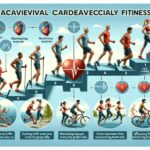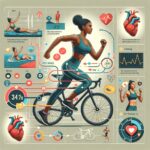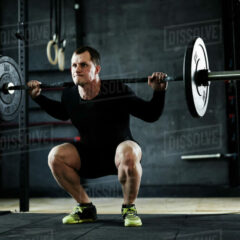https://weightliftingforpower.com/the-process-of-achieving-optimal-cardiovascular-fitness/
Optimal Cardiovascular fitness is more than a buzzword; it’s a critical component of your well-being. Cardiovascular fitness is the term used to describe the capability of the heart, lungs, and circulatory system to provide oxygen and nutrients to the body while participating in physical activity. Why does this matter? Opium cardiovascular fitness is associated with a reduced risk for chronic diseases, notably heart disease, the leading cause of death globally.


What is the ideal cardio fitness?
Doing more than the recommended minimum—up to 300 minutes of moderate activity per week—can help you shed those extra pounds.
When discussing cardiovascular fitness, I refer to three vital components: endurance, strength, and flexibility. Consider these the trio that compose a symphony of movement. Endurance is your body’s ability to engage in aerobic activities like running or swimming for extended periods. St length pertains to the heart muscle’s power, enabling it to pump blood effectively. La toy, the flexibility of the blood vessels ensures they can expand and contract as needed, supporting blood flow.
Several assessments measure fitness levels if you’re curious about your cardiovascular health. You can evaluate your stress levels by monitoring your heart rate and breathing while exercising or tracking how fast your heart rate returns to its average pace after a workout. These benchmarks are helpful starting points to tailor a plan that works for you.
Remember, the goal here is not to prepare for a marathon overnight but to create a habit of physical activity that suits your lifestyle and enhances your health. Creating Your Cardiovascular Fitness Plan: A Personalized Approach
Embarking on the journey towards achieving optimal cardiovascular fitness requires a well-planned approach. It’s essential to have a clear strategy in place to achieve your fitness goals. You examine your unique circumstances to devise an effective and sustainable program. Let’s walk through the steps to create a plan tailored just for you.
Your first step is to establish goals that are not only ambitious but realistic. Whether you are training for a marathon or simply getting to the point where you can climb stairs without getting winded, your goals should motivate you to set SMART goals – Specific, Measurable, Achievable, Relevant, and Time-bound – to elevate your chances of success.
With goals in place, it’s time to look at the exercises that can get you there. Cardiovascular exercises come in many forms, from running and swimming to cycling and rowing. Choose activities you enjoy, as this will help you stick with them longer—alternate high-intensity exercises like sprinting with low-intensity sessions such as biking or walking for a well-rounded workout routine.
You’ll need to balance the intensity and duration of your exercises to avoid burnout and injuries. “To avoid injury and help your body adapt to higher levels of activity, it is important to gradually increase the intensity over time, allowing your body to adjust before increasing further.” A heart rate monitor can be helpful here; it helps you train at the right intensity based on your fitness level and goals.
Lastly, take into account the value of professional guidance. A certified fitness trainer or a health coach can help tailor your fitness plan, teach you proper technique, and ensure you exercise safely, particularly if you’re new to fitness or have pre-existing health conditions.
Nutrition and Recovery: Essential Elements of Cardiovascular Training
What is the best for cardiovascular fitness?
When it comes to cardiovascular fitness, there’s simply no one-size-fits-all solution.
Achieving optimal cardiovascular fitness is more than just the time spent running on a track or cycling up a hill. It’s equally about what happens in the kitchen and during downtime. The foods you eat are pivotal in fueling your body for exercise and repairing it afterward.
A heart-healthy diet comprises fruits, vegetables, whole grains, and lean proteins. These foods provide the vitamins, minerals, and antioxidants your body needs to perform at its best. Om ga-3 fatty acids in fish like salmon are known for their cardiovascular benefits. Hydration is also critical; water enables blood circulation and the transportation of nutrients in the body.
But training doesn’t end with nutrition; recovery is a cornerstone of any fitness regimen. Your body needs time to repair and strengthen itself after each workout. Includes quality sleep, which allows for essential physiological repairs, and rest days to prevent overtraining.
Stress, too, can have a significant impact on cardiovascular health. Stress can negatively impact cardiovascular health, but effective stress management techniques can help improve it.
As you transition to tracking progress and staying motivated, remember that the proper diet and recovery practices are integral. By honoring your body’s needs in activity and rest, you set the stage for consistent improvement and long-term success in your fitness journey.
Tracking Progress and Staying Motivated: The Journey to Peak Cardio Fitness
Measuring improvements in cardiovascular fitness isn’t just essential for tracking your progress—it’s a powerful motivator. As you embark on this journey, using the right tools and methods to assess your improvement can reaffirm your commitment to the process. Regular check-ins on your endurance levels, for instance, through time trials or distance covered, can give you concrete evidence of your advances.
What is the optimal amount of cardio for health?
at least 150 minutes of moderate-intensity cardio each week.
Celebrating small victories is crucial to maintaining a positive mindset. Every extra minute you run, each additional lap you swim, or the new personal best you achieve on the bike is a stepping-stone towards your larger goal. Ac knowledge of these milestones and consider rewarding yourself in a way that supports your fitness journey.
What is the meaning of cardiovascular fitness?
Cardiovascular fitness refers to how well your heart and lungs work together to supply your body with oxygen during physical activity.
Over time, you might hit a plateau. It’s natural, and it happens to everyone. When progress stalls, it’s time to re-evaluate and adjust your plan. It could mean changing your routine, adding cross-training, or consulting a fitness professional for additional insight.
Your attitude can make or break your journey to peak cardiovascular fitness. Keep motivation high by setting new goals, trying different activities to keep things fresh, and remembering WHY you started. The rewards worth pushing for are the sense of accomplishment, the surge of energy, and the longevity you’re working toward.
https://www.wealthyaffiliate.com?a_aid=352a86b2
Best Exercises For Weight Loss quickly Boost
https://weightliftingforpower.com/fitness-goal-setting/
https://weightliftingforpower.com/strengthen-a-powerful-core/
